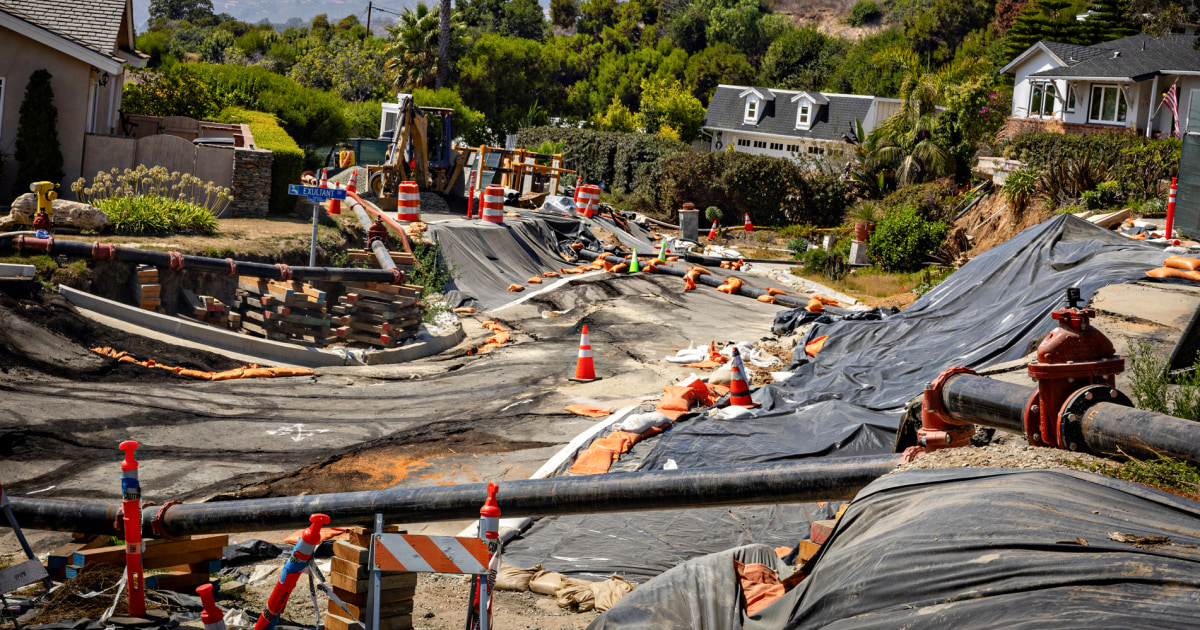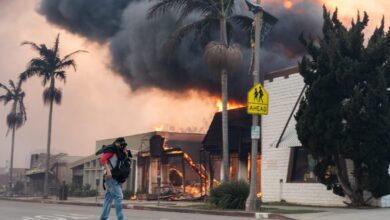Power cut to 245 homes in coastal California community where landslides are worsening

In a coastal Southern California city where multimillion-dollar estates teeter above the Pacific Ocean, power remained intentionally severed Tuesday to about 245 homes as worsening landslides have triggered evacuation warnings and a gas service shutoff.
Utility provider Southern California Edison on Monday evening cut electricity to another 105 homes in a section of Rancho Palos Verdes known as Seaview for “varying lengths of time” — some to go without service for as few as 24 hours or as long as indefinitely, the city said.
That’s in addition to the 140 homes that have been without power since Sunday in Rancho Palos Verdes, about 25 miles south of Los Angeles, leaving some residents in the city of 42,000 to scramble to find alternative housing.
“The land movement in the Portuguese Bend community has created such a dangerous situation that we have made the very difficult decision to disconnect power indefinitely to prevent that equipment from igniting wildfire,” Larry Chung, Southern California Edison’s vice president of customer engagement, said at a news conference.
A power line had fallen in the Portuguese Bend neighborhood last week, sparking a small fire. The power shutoff led city officials to prompt residents in affected areas to begin evacuation plans; an emergency assistance center was opened to help with charging cellphones, and relocation and mental health support.
“This is an ever-changing crisis as we navigate through this, and we need to be prepared,” Rancho Palos Verdes City Manager Ara Mihranian said at Sunday’s news conference. “That is the only way we can stay safe.”
As of Monday morning, evacuations were not mandatory, but city officials asked affected residents who choose to remain in their homes to “limit their use of water and plumbing, especially overnight when generators may be turned off for periods at a time.” For now, generators are helping to keep the sewer system running, they said.
The land in Rancho Palos Verdes, situated atop the bluffs of the Palos Verdes Peninsula and home to prime real estate, including the Trump National Golf Club Los Angeles, has been shifting since the 1950s. But geologists say it is moving at a rate of more than a foot a week in some areas, threatening certain neighborhoods.
Scientists began testing the area following the shut-off of gas service last month in Portuguese Bend after “significant new land movement” was putting a “strain” on infrastructure. City Public Works Director Ramzi Awwad said at a recent council meeting that the land movement was “new and unprecedented.”
An increase in heavy rains over the past two years has only exacerbated the problem along California’s coast, with water saturating the hillsides. Climate change is also intensifying the rates of rainfall throughout the country.
In Rancho Palos Verdes, the popular Wayfarers Chapel, a Frank Lloyd Wright Jr.-designed national historic landmark that has overlooked the ocean since 1951, has been temporarily closed since February because of rains accelerating land movement.
Mayor John Cruikshank said last month that the city would conduct voluntary inspections of homes rather than the forced tagging of residences to indicate which ones may be uninhabitable.
“We’re also working with all the utility partners to keep all the utilities on and to restore the gas eventually once the landslide gets to a more manageable rate of movement,” he told NBC Los Angeles.
But while city and county officials said Sunday that turning off power was a necessary precaution, residents expressed frustration that they were only given a 24-hour warning, and had to find other housing arrangements or source equipment to help with living in homes without utilities.
“I just recently purchased an induction cooktop to deal with no gas, and now I can’t even use that,” resident Craig Cadwallader told NBC Los Angeles on Sunday. “It’s pretty serious and a little uncomfortable to say the least.”
At Sunday’s news conference, Los Angeles County Supervisor Janice Hahn urged the state to help provide support as well and for Gov. Gavin Newsom to visit. What’s happening there, she added, is an emergency with no playbook.
“This is bigger than Rancho Palos Verdes,” she said. “This land movement is so gigantic and so damaging, that one city should not have to bear the burden alone.”




